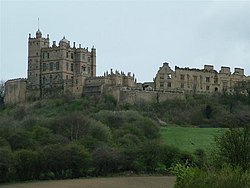Bolsover Castle
| Bolsover Castle | |
|
Derbyshire | |
|---|---|
 Bolsover Castle | |
| Location | |
| Grid reference: | SK471707 |
| Location: | 53°13’53"N, 1°17’49"W |
| Town: | Bolsover |
| History | |
| Information | |
| Owned by: | English Heritage |
| Website: | Bolsover Castle |
Bolsover Castle is a castle in Bolsover in Derbyshire. It was founded in the 12th century by the Peverel family, who also owned Peveril Castle in Derbyshire, and came under royal control in 1155. The site is now in the care of English Heritage and is a Grade I listed building and a Scheduled Ancient Monument.
History
Middle Ages
A castle was built by the Peverel family in the 12th century and became Crown property in 1155 when William Peverel the Younger died. The Ferrers family who were Earls of Derby laid claim to the Peveril property.[1]
When a group of barons led by King Henry II's – Henry 'the Young King']], Geoffrey II, Duke of Brittany, and Prince Richard (later Richard the Lionheart) - revolted against the king's rule, Henry spent £116 on building at the castles of Bolsover and Peveril in Derbyshire.[2][3] The garrison was increased to a force led by twenty knights and was shared with the castles of Peveril and Nottingham during the revolt.[2] King John ascended the throne in 1199 after his brother Richard's death. William de Ferrers maintained the claim of the Earls of Derby to the Peveril estates. He paid John 2000 marks for the lordship of the Peak, but the Crown retained possession of Bolsover and Peveril Castles. John finally gave them to Ferrers in 1216 to secure his support in the face of country-wide rebellion. However, the castellan Brian de Lisle refused to hand them over. Although Lisle and Ferrers were both John's supporters, John gave Ferrers permission to use force to take the castles. The situation was still chaotic when the infant Henry III became king after his father's death in 1216. Bolsover fell to Ferrers' forces in 1217 after a siege.[4]
The castle was returned to crown control in 1223, at which point £33 was spent on repairing the damage the Earl of Derby had caused when capturing the castle six years earlier. Over the next 20 years, four towers were added, the keep was repaired, various parts of the curtain wall were repaired, and a kitchen and barn were built, all at a cost of £181. From 1290 onwards, the castle and its surrounding manor were granted to a series of local farmers. Under their custodianship, the castle gradually fell into a state of disrepair.[5]
Modern period
The manor and castle were purchased by Sir George Talbot in 1553. They were sold by Gilbert, 7th Earl of Shrewsbury to Sir Charles Cavendish, son of Bess of Hardwick in 1608. Sir Charles set about re-building the castle, a process continued by his son William Cavendish, later 1st Duke of Newcastle upon Tyne.[1] Despite its embattled appearance, the castle was designed for elegant living rather than defence. The tower, known today as the 'Little Castle', was completed around 1621.[6]
During the Civil War, Bolsover Castle was taken by the Parliamentarians, who slighted it and it fell into a ruinous state.[1] William Cavendish added a new hall and staterooms to the Terrace Range and, by the time of his death in 1676, the castle had been restored to good order.[6] It passed through he female line into the Bentinck family, and ultimately became one of the seats of the Dukes of Portland.
After 1883 the castle was uninhabited and given to the nation by the 7th Duke of Portland in 1945. The castle is now in the care of English Heritage.[6]
Bolsover Castle is a Scheduled Ancient Monument,[7] a "nationally important" historic building and archaeological site which has been given protection against unauthorised change.[8] It is also a Grade I listed building (first listed in 1985)[9] and recognised as an internationally important structure.
The exterior of the long gallery
The Little Castle at Bolsover
Model of Bolsover Castle as it may have looked in the late 1600s.
Outside links
| ("Wikimedia Commons" has material about Bolsover Castle) |
- Bolsover Castle - English Heritage
- Gatehouse Gazetteer record for Bolsover Castle
- Photographs around the Castle
- History and photos of Bolsover Castle
References
- ↑ 1.0 1.1 1.2 A Topographical Dictionary of England (1848)
- ↑ 2.0 2.1 Eales 2006, p. 23
- ↑ Colvin & Brown 1963, p. 572
- ↑ Eales 2006, p. 24
- ↑ Colvin & Brown 1963, p. 573
- ↑ 6.0 6.1 6.2 Fry 1980
- ↑ "Bolsover Castle", Pastscape (English Heritage), http://www.pastscape.org.uk/hob.aspx?hob_id=316209, retrieved 2012-04-17
- ↑ "Scheduled Monuments", Pastscape (English Heritage), http://www.english-heritage.org.uk/caring/listing/scheduled-monuments/, retrieved 2012-04-17
- ↑ Bolsover Castle, Heritage Gateway, http://www.heritagegateway.org.uk/Gateway/Results_Single.aspx?uid=1108976&resourceID=5, retrieved 2012-04-17
- Colvin, H. M.; Brown, R. A. (1963), "The Royal Castles 1066–1485", The History of the King's Works. Volume II: The Middle Ages, London: Her Majesty's Stationery Office, pp. 553–894
- Eales, Richard (2006), Peveril Castle, London: English Heritage, ISBN 978-1-85074-982-0
- Fry, Plantagenet Somerset (1980), The David & Charles Book of Castles, David & Charles, ISBN 0-7153-7976-3
Books
- Worsley, Lucy (2010) [2000], Bolsover Castle (revised ed.), London: English Heritage, ISBN 978-1-85074-762-8
- Worsley, Lucy (May 2004). "Changing Notions of Authenticity: Presenting a Castle Over Four Centuries". International Journal of Heritage Studies 10 (2): 129–149. doi:10.1080/13527250410001692868.